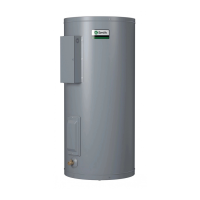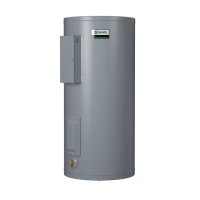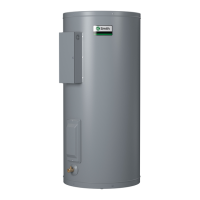Do you have a question about the A.O. Smith DEL-20 and is the answer not in the manual?
Identifies the specific A.O. Smith water heater models this manual covers.
Outlines key topics: Installation, Operation, Service, Maintenance, and Warranty.
Explains the safety alert symbol and its purpose in warning about potential hazards.
Defines DANGER, WARNING, and CAUTION levels for safety messages and their implications.
Mentions the California Act and potential chemical exposure warnings.
Provides definitions for terms like "Qualified Installer or Service Agency."
Lists essential safety precautions before installation, operation, or servicing.
Warns about flammable hydrogen gas and necessary precautions.
Emphasizes turning off power before accessing panels and potential injury risks.
Highlights risks like operating flood-damaged units or improper installation.
Warns about severe burns from high water temperatures and vulnerable individuals.
Alerts to tank explosions from overheated water and the need for a relief valve.
Stresses reading the entire manual for safe operation and to prevent injury or damage.
Details requirements for conforming to instructions, local codes, and power company regulations.
Provides information on contacting technical support for questions or assistance.
Provides tables and diagrams for physical dimensions of various models.
Lists water recovery rates based on element input and temperature rise.
Shows the layout and fields of rating plates for commercial and electric models.
Illustrates typical installation configurations for DEN/DEL dual and single element heaters.
Discusses factors like proximity to piping, freezing temperatures, and potential leakage damage.
Specifies minimum clearances required for servicing and accessing parts.
Alerts to the hazard of immersion in water and the need for examination by a service person.
States the need for qualified installer or service agency with plumbing and electrical skills.
Covers compliance with codes, power company rules, and electrical grounding.
Details the importance and specifications of the T&P relief valve for safety.
Advises on using mixing valves to prevent scalding, especially for vulnerable users.
Explains thermal expansion in closed systems and the need for an expansion tank.
Details how to determine the correct branch circuit wire size based on amperage ratings and codes.
Provides methods and tables for calculating heater amperage and selecting overcurrent protection.
Shows wiring configurations for dual element heaters, including 3-phase and single-phase options.
Illustrates wiring for single element heaters with a high limit control.
Step-by-step guide on how to properly fill the water heater tank before operation.
Procedures for checking connections, resetting thermostats, and verifying operation after installation.
Instructions on how to safely drain the water heater for shutdown or maintenance.
Describes the types of thermostats used and their adjustment methods.
Details how to safely adjust water temperature settings using the thermostats.
Explains the purpose and procedure for inspecting the anode rod to prevent tank corrosion.
Lists common causes and checks for insufficient hot water supply.
Addresses noises like sizzling or hissing and their potential causes like sediment buildup.
Guides on checking for leaks at drain valves, relief valves, and element connections.
Details how to identify and fix leaks originating from heating elements or their gaskets.
Differentiates between condensation and actual pipe leaks and how to check them.
Explains how to identify and address leaks from the relief valve and drain valve.
Outlines the warranty coverage for the glass-lined tank against natural corrosion.
Details the warranty for other parts against defects in material or workmanship.
Lists essential conditions and exceptions that must be met for the warranty to apply.
Instructs on how to initiate a warranty claim by contacting the dealer or manufacturer.
Provides essential information required when ordering replacement parts, including model and serial numbers.
Identifies the specific A.O. Smith water heater models this manual covers.
Outlines key topics: Installation, Operation, Service, Maintenance, and Warranty.
Explains the safety alert symbol and its purpose in warning about potential hazards.
Defines DANGER, WARNING, and CAUTION levels for safety messages and their implications.
Mentions the California Act and potential chemical exposure warnings.
Provides definitions for terms like "Qualified Installer or Service Agency."
Lists essential safety precautions before installation, operation, or servicing.
Warns about flammable hydrogen gas and necessary precautions.
Emphasizes turning off power before accessing panels and potential injury risks.
Highlights risks like operating flood-damaged units or improper installation.
Warns about severe burns from high water temperatures and vulnerable individuals.
Alerts to tank explosions from overheated water and the need for a relief valve.
Stresses reading the entire manual for safe operation and to prevent injury or damage.
Details requirements for conforming to instructions, local codes, and power company regulations.
Provides information on contacting technical support for questions or assistance.
Provides tables and diagrams for physical dimensions of various models.
Lists water recovery rates based on element input and temperature rise.
Shows the layout and fields of rating plates for commercial and electric models.
Illustrates typical installation configurations for DEN/DEL dual and single element heaters.
Discusses factors like proximity to piping, freezing temperatures, and potential leakage damage.
Specifies minimum clearances required for servicing and accessing parts.
Alerts to the hazard of immersion in water and the need for examination by a service person.
States the need for qualified installer or service agency with plumbing and electrical skills.
Covers compliance with codes, power company rules, and electrical grounding.
Details the importance and specifications of the T&P relief valve for safety.
Advises on using mixing valves to prevent scalding, especially for vulnerable users.
Explains thermal expansion in closed systems and the need for an expansion tank.
Details how to determine the correct branch circuit wire size based on amperage ratings and codes.
Provides methods and tables for calculating heater amperage and selecting overcurrent protection.
Shows wiring configurations for dual element heaters, including 3-phase and single-phase options.
Illustrates wiring for single element heaters with a high limit control.
Step-by-step guide on how to properly fill the water heater tank before operation.
Procedures for checking connections, resetting thermostats, and verifying operation after installation.
Instructions on how to safely drain the water heater for shutdown or maintenance.
Describes the types of thermostats used and their adjustment methods.
Details how to safely adjust water temperature settings using the thermostats.
Explains the purpose and procedure for inspecting the anode rod to prevent tank corrosion.
Lists common causes and checks for insufficient hot water supply.
Addresses noises like sizzling or hissing and their potential causes like sediment buildup.
Guides on checking for leaks at drain valves, relief valves, and element connections.
Details how to identify and fix leaks originating from heating elements or their gaskets.
Differentiates between condensation and actual pipe leaks and how to check them.
Explains how to identify and address leaks from the relief valve and drain valve.
Outlines the warranty coverage for the glass-lined tank against natural corrosion.
Details the warranty for other parts against defects in material or workmanship.
Lists essential conditions and exceptions that must be met for the warranty to apply.
Instructs on how to initiate a warranty claim by contacting the dealer or manufacturer.
Provides essential information required when ordering replacement parts, including model and serial numbers.
| Capacity | 20 Liters |
|---|---|
| Heating Element | Copper |
| Thermostat | Adjustable |
| Pressure Rating | 8 bar |
| Type | Electric Storage Water Heater |
| Power Consumption | 2000 Watts |
| Voltage | 230V |
| Safety Features | Thermal Cutout, Pressure Relief Valve |
| Warranty | 5 years |












